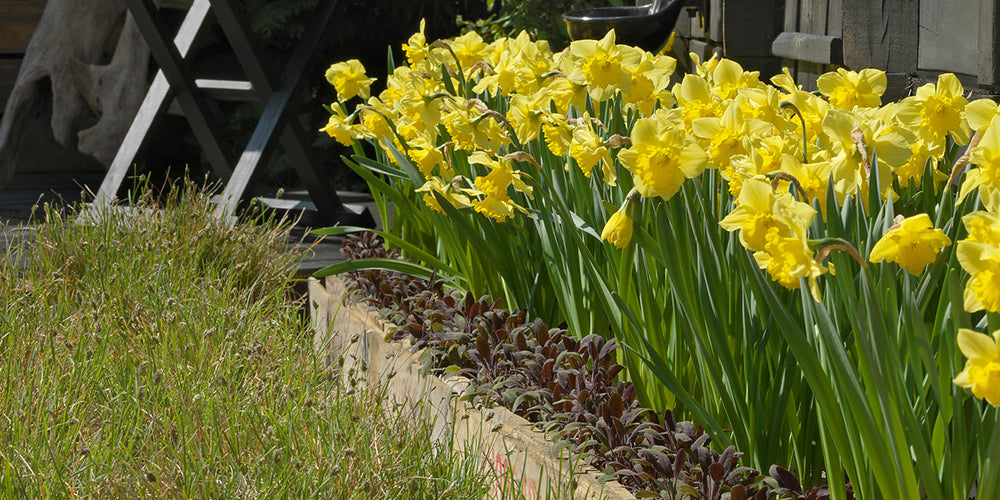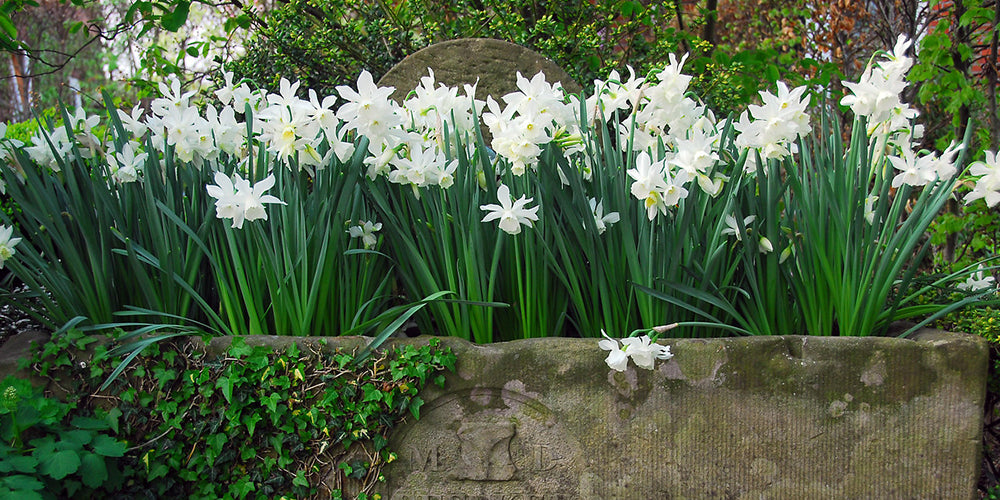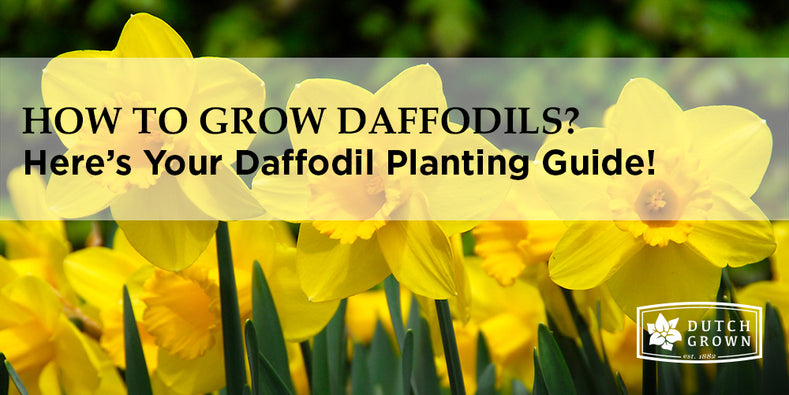How to Grow Daffodils?
DAFFODILS & NARCISSUS PLANTING GUIDE
Nothing says “spring is coming” like daffodils & narcissus. Suddenly they seem to pop up all around you, when only a week ago there was just dull grass and assorted winter detritus. With their beautiful yellow petals, long cups and star-shaped blooms, they are bound to delight anyone who sees them.
As an added bonus, daffodils & narcissus are great natural repellents to squirrels and other rodents.
QUICK GUIDE
-
WHEN
Plant in fall
Blooms in spring
-
WHERE
Hardiness zone 3-8
Full sun or partial shade
Well-draining soil
-
WATER
Once after planting
Moderately in spring
-
WIDTH & DEPTH
Width: 4-6” apart
Depth: 4-8”
Arrival
When your DutchGrown daffodils arrive and you can’t plant them immediately, it’s important to store them correctly: unpack them right away and put them in a dry place with plenty of air circulation, where the temperature is between 40 and 70 degrees Fahrenheit.
Garden & Container Planting
Like all flower bulbs, daffodils need a cold period to develop their roots and get ready for spring. So once you feel fall’s first chill in the air, it’s time to get planting. If you live in hardiness zone 9 or higher, the soil won’t get cold enough for the root-developing process to happen, but you might consider forcing
Flower bulbs are tough cookies that are easy to grow, but one thing they hate is getting their feet wet: a bulb that is ‘bathing’ in water will rot in no time. So avoid soggy soil at all cost – this means places where you can still see puddles 5-6 hours after a rainstorm. Another thing you can do is to upgrade potentially soggy soil by adding organic material such as peat, bark or manure. When it comes to planting bulbs in containers, the mantra is exactly the same: drainage-drainage-drainage. Get a pot or box with at least some drainage holes at the bottom.
Daffodils need the sun to grow, but though they adore basking in its glory all day, they can also do very well in places with dappled shade or scattered sunlight.
Daffodils will need to be planted deep enough that they won’t be affected by temperature variations above ground, either too warm or too cold. Unfortunately containers can’t protect bulbs as well as mother earth can, so when you live in hardiness zones 3-7 it might be better to let your containers spend the winter indoors, in a cool, dark, well-aired spot that won’t get warmer than 60 degrees Fahrenheit, like an unheated basement or garage.
The standard method for calculating the ideal depth is to dig a hole three times as deep as the bulb is high, and place the bulb at the bottom with its pointy end up. Since daffodils grow less well when they have to fight for nutrients with their fellow bulbs, it’s best to plant them 4-5” apart.
To help the bulbs settle and grow roots quickly, it’s important to water them well after planting, but after that you won’t have to water them again. Now all you have to do is wait patiently for winter to do its magic underground, and spring to surprise you with the rewards of your work.
During blooming season, you generally don’t have to water your daffodils, but you can water them when there hasn’t been any rain for 3-5 days.
After daffodils have finished blooming, don’t cut the foliage straight away: through photosynthesis the leaves will create nutrients that the bulb will be needing for its next growing season. After a few weeks the foliage will automatically yellow and die back, and then you can remove it. Now the bulb will be going dormant, and won’t need any watering until next spring.
How to plant daffodils in your garden:
- Wait until the soil is 60 degrees Fahrenheit or colder. In the North this will be in September or October, in the South in October or November.
- Pick a spot in your garden that has well-draining soil and gets full sun or partial shade.
- Plant the daffodil bulbs about 3-6” deep and 4-5” apart, placing them in the ground with their pointy ends up.
- Water well once and wait for spring
- After the daffodils have bloomed don’t cut off the foliage. Leave it until it’s completely withered and yellow, then remove.

How to plant daffodils in pots or containers:
- Wait until it’s cold outside, with a soil temperature of 60 degrees Fahrenheit or lower. In the North this will be in September or October, in the South in October or November.
- Pick a spot in your garden that gets full sun or partial shade.
- Find a well-draining container and fill it with loose soil, making sure water won’t gather and stay at the bottom.
- Plant the daffodil bulbs about 4-6” deep and 3-4” apart, placing them in the soil with their pointy ends up. Since containers often have limited space, you can also experiment with placing the bulbs closer together, but make sure they never touch.
- Water well once and wait for spring, or, when you live in hardiness zone 3-7, water well and bring the containers indoors, letting them spend the winter in a cool spot like an unheated garage or basement.
- After the daffodils have bloomed don’t cut off the foliage. Leave it until it’s completely withered and yellow, then remove.

Special Variety
If you simply can’t wait for spring or live in hardiness zone 8-10, daffodils & narcissus have a lovely variety called paperwhites that doesn’t need any cooling period at all, making it ideal for indoor blooming or warmer climates.
- For indoor growing:
Plant the paperwhite bulbs in a well-draining container, with 1” of the tip of the bulb sticking out of the soil. Place the bulbs very closely together so they won’t get floppy once they grow taller. After planting, place the pot in a brightly lit, warm spot. Make sure to turn the pot every day so that the plants will grow straight. After three to six weeks you’ll have a lovely pot of tender white flowers that smell divine.
Instead of in a pot with soil, you can also use a (glass) vase. Fill the bottom with pebbles or gravel and place the bulbs closely together on top of it, with their pointy ends up. Water until it just reaches the base of the bulbs, and place the vase in a brightly lit but not too warm spot. Make sure to keep topping up the water as it evaporates.
- For outdoor growing in zones 8-10:
Anytime in winter, find a sunny spot with well-draining soil and plant the paperwhite bulbs 3x deeper than they’re high, with their pointy ends up. For maximum impact it’s a good idea to plant them in clumps of 7-10. Water well after planting and wait for spring, when they’ll burst forth form the ground in tender, fragrant groups.


